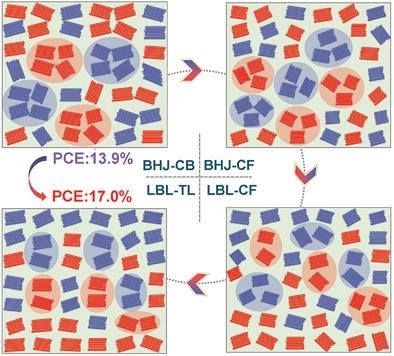当前位置:
X-MOL 学术
›
Adv. Mater.
›
论文详情
Our official English website, www.x-mol.net, welcomes your
feedback! (Note: you will need to create a separate account there.)
A Top-Down Strategy to Engineer ActiveLayer Morphology for Highly Efficient and Stable All-Polymer Solar Cells
Advanced Materials ( IF 27.4 ) Pub Date : 2022-06-24 , DOI: 10.1002/adma.202202608 Huiting Fu 1, 2 , Zhengxing Peng 3 , Qunping Fan 2, 4 , Francis R Lin 2, 4 , Feng Qi 2, 4 , Yixin Ran 5 , Ziang Wu 6 , Baobing Fan 2, 4 , Kui Jiang 1, 2 , Han Young Woo 6 , Guanghao Lu 5 , Harald Ade 3 , Alex K-Y Jen 1, 2, 4, 7
Advanced Materials ( IF 27.4 ) Pub Date : 2022-06-24 , DOI: 10.1002/adma.202202608 Huiting Fu 1, 2 , Zhengxing Peng 3 , Qunping Fan 2, 4 , Francis R Lin 2, 4 , Feng Qi 2, 4 , Yixin Ran 5 , Ziang Wu 6 , Baobing Fan 2, 4 , Kui Jiang 1, 2 , Han Young Woo 6 , Guanghao Lu 5 , Harald Ade 3 , Alex K-Y Jen 1, 2, 4, 7
Affiliation

|
A major challenge hindering the further development of all-polymer solar cells (all-PSCs) employing polymerized small-molecule acceptors is the relatively low fill factor (FF) due to the difficulty in controlling the active-layer morphology. The issues typically arise from oversized phase separation resulting from the thermodynamically unfavorable mixing between two macromolecular species, and disordered molecular orientation/packing of highly anisotropic polymer chains. Herein, a facile top-down controlling strategy to engineer the morphology of all-polymer blends is developed by leveraging the layer-by-layer (LBL) deposition. Optimal intermixing of polymer components can be achieved in the two-step process by tuning the bottom-layer polymer swelling during top-layer deposition. Consequently, both the molecular orientation/packing of the bottom layer and the molecular ordering of the top layer can be optimized with a suitable top-layer processing solvent. A favorable morphology with gradient vertical composition distribution for efficient charge transport and extraction is therefore realized, affording a high all-PSC efficiency of 17.0% with a FF of 76.1%. The derived devices also possess excellent long-term thermal stability and can retain >90% of their initial efficiencies after being annealed at 65 °C for 1300 h. These results validate the distinct advantages of employing an LBL processing protocol to fabricate high-performance all-PSCs.
中文翻译:

一种自上而下的策略来设计高效和稳定的全聚合物太阳能电池的 ActiveLayer 形态
阻碍采用聚合小分子受体的全聚合物太阳能电池 (all-PSC) 进一步发展的主要挑战是由于难以控制活性层形态而导致的相对较低的填充因子 (FF)。这些问题通常源于两种大分子物质之间在热力学上不利的混合以及高度各向异性聚合物链的无序分子取向/堆积导致的过大相分离。在此,通过利用逐层(LBL)沉积开发了一种简单的自上而下控制策略来设计全聚合物共混物的形态。通过在顶层沉积过程中调整底层聚合物的溶胀,可以在两步工艺中实现聚合物组分的最佳混合。最后,底层的分子取向/堆积和顶层的分子排列都可以用合适的顶层处理溶剂进行优化。因此,实现了具有梯度垂直成分分布的有利形态,用于有效的电荷传输和提取,提供 17.0% 的高全 PSC 效率和 76.1% 的 FF。衍生器件还具有出色的长期热稳定性,在 65°C 退火 1300 小时后仍可保持 >90% 的初始效率。这些结果验证了采用 LBL 处理协议制造高性能全 PSC 的独特优势。因此,实现了具有梯度垂直成分分布的有利形态,用于有效的电荷传输和提取,提供 17.0% 的高全 PSC 效率和 76.1% 的 FF。衍生器件还具有出色的长期热稳定性,在 65°C 退火 1300 小时后仍可保持 >90% 的初始效率。这些结果验证了采用 LBL 处理协议制造高性能全 PSC 的独特优势。因此,实现了具有梯度垂直成分分布的有利形态,用于有效的电荷传输和提取,提供 17.0% 的高全 PSC 效率和 76.1% 的 FF。衍生器件还具有出色的长期热稳定性,在 65°C 退火 1300 小时后仍可保持 >90% 的初始效率。这些结果验证了采用 LBL 处理协议制造高性能全 PSC 的独特优势。
更新日期:2022-06-24
中文翻译:

一种自上而下的策略来设计高效和稳定的全聚合物太阳能电池的 ActiveLayer 形态
阻碍采用聚合小分子受体的全聚合物太阳能电池 (all-PSC) 进一步发展的主要挑战是由于难以控制活性层形态而导致的相对较低的填充因子 (FF)。这些问题通常源于两种大分子物质之间在热力学上不利的混合以及高度各向异性聚合物链的无序分子取向/堆积导致的过大相分离。在此,通过利用逐层(LBL)沉积开发了一种简单的自上而下控制策略来设计全聚合物共混物的形态。通过在顶层沉积过程中调整底层聚合物的溶胀,可以在两步工艺中实现聚合物组分的最佳混合。最后,底层的分子取向/堆积和顶层的分子排列都可以用合适的顶层处理溶剂进行优化。因此,实现了具有梯度垂直成分分布的有利形态,用于有效的电荷传输和提取,提供 17.0% 的高全 PSC 效率和 76.1% 的 FF。衍生器件还具有出色的长期热稳定性,在 65°C 退火 1300 小时后仍可保持 >90% 的初始效率。这些结果验证了采用 LBL 处理协议制造高性能全 PSC 的独特优势。因此,实现了具有梯度垂直成分分布的有利形态,用于有效的电荷传输和提取,提供 17.0% 的高全 PSC 效率和 76.1% 的 FF。衍生器件还具有出色的长期热稳定性,在 65°C 退火 1300 小时后仍可保持 >90% 的初始效率。这些结果验证了采用 LBL 处理协议制造高性能全 PSC 的独特优势。因此,实现了具有梯度垂直成分分布的有利形态,用于有效的电荷传输和提取,提供 17.0% 的高全 PSC 效率和 76.1% 的 FF。衍生器件还具有出色的长期热稳定性,在 65°C 退火 1300 小时后仍可保持 >90% 的初始效率。这些结果验证了采用 LBL 处理协议制造高性能全 PSC 的独特优势。











































 京公网安备 11010802027423号
京公网安备 11010802027423号